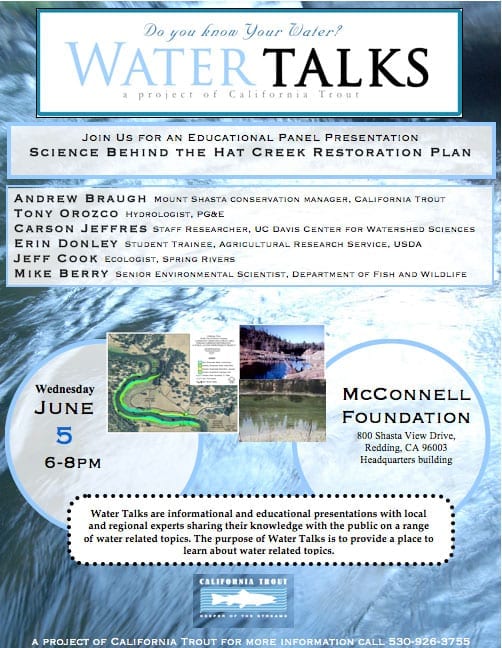Water Talks: The Science Behind the Hat Creek Restoration Plan
For Immediate Release: May 16th, 2013
Contact: Meadow Barr, 530-859-1411
Shasta County-CA
Siskiyou County-CA
Did you know that Hat Creek was once California’s premier spring creek fishery? Come learn about Hat Creek’s unique characteristics, why it fell on hard times, and what is being done to fix it.
The public is invited to an educational presentation, “Water Talks: The Science Behind the Hat Creek Restoration Plan” on Wednesday June 5th 2013 from 6:00 pm to 8:00 pm at the McConnell Foundation headquarters building located at 800 Shasta View Drive in Redding. The informational Water Talks are free and open to the public. Please RSVP to mbarr@caltrout.org as seating is limited at the McConnell Foundation.
“Water Talks: The Science Behind the Hat Creek Restoration Plan” will feature presentations from:
- Andrew Braugh Mount Shasta Conservation Manager, California Trout
- Tony Orozco Hydrologist, PG&E
- Jeff Cook Ecologist, Spring Rivers
- Carson Jeffres Staff Researcher, UC Davis Center for Watershed Sciences
- Erin Donley Student Trainee, USDA Agricultural Research Service and Ph.D. student, UC Davis Department of Entomology
- Mike Berry Senior Environmental Scientist, Department of Fish and Wildlife.
In November of 2012 California Trout received a grant from the California Natural Resources Agency to restore fish habitat and create new recreational opportunities on Hat Creek. Andrew Braugh, California Trout’s Mount Shasta Conservation Manager will be managing the project.
“The Hat Creek Restoration project is an example of what can be accomplished when public and private organizations work together to manage northern California’s natural resources. Hat Creek was once California’s most important spring creek wild trout fishery; our restoration partnership is committed to bringing this special place back to life,” Braugh said.
“Presentations like these help me understand the broader scope of the project and encourage me to contribute in the capacity that I can,” stated Tony Orozco, a PG&E hydrologist. “I will discuss the unique characteristics of the Hat Creek Watershed, the hydrology of Hat Creek and provide an overview of PG&E’s power generation on Hat Creek,” he said.
Jeff Cook, an ecologist at Spring Rivers has been conducting studies, working, and fishing on Hat Creek since 1996 and a part of the Hat Creek Restoration planning since 2003. His studies have included trout spawning surveys, rare species surveys, identification of sediment sources and influx rates, and in-stream sediment transport studies. “In my portions of the talk I will cover the geologic history and geomorphology of Hat Creek as well as the existing ecological conditions and how they tie to the science behind the planned restoration activities,” he said.
“My research interest is understanding how nutrients in the underlying geology can be incorporated into groundwater, emerge as springs, and ultimately provide the base of a productive foodweb,” said Carson Jeffres, Staff Researcher for the UC Davis Center for Watershed Sciences.
Jeffres’ presentation will set the stage for Erin Donley, who is a student researcher at the USDA and a Ph.D. student in the Department of Entomology at UC Davis. “I will cover the unique characteristics of spring creek food web dynamics,” she said.
The Department of Fish and Wildlife has managed a portion of Hat Creek as a Wild Trout water since 1972. “I will share the results of recent trout population and creel studies, and discuss how restoration actions will benefit wild trout populations,” said Mike Berry, a senior environmental scientist with the Department.
Attendees can expect to come away with a better understanding of the story behind why Hat Creek needs restoration, the science behind the restoration plan, and the restoration actions beginning this summer.
Water Talks are an ongoing series of informational and educational presentations with local and regional experts sharing their knowledge with the public on a range of water related topics. The purpose of Water Talks is to provide a place to learn about water related topics. Water Talks is a project of California Trout. California Trout is a nonprofit organization dedicated to seeking workable solutions for fisheries restoration throughout California.” For more information contact Meadow Barr, California Trout Outreach Consultant at 530-859-1411 or mbarr@caltrout.org.





